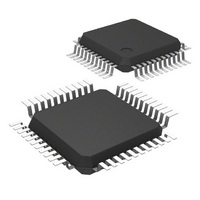MICRF500BLQTR Micrel Inc, MICRF500BLQTR Datasheet

MICRF500BLQTR
Specifications of MICRF500BLQTR
Related parts for MICRF500BLQTR
MICRF500BLQTR Summary of contents
Page 1
MICRF500 General Description The MICRF500 is a single chip UHF transceiver designed for spread spectrum communication (FHSS) intended for ISM (Industrial, Scientific and Medical) and SRD (Short Range Device) frequency bands from 700MHz to 1100MHz with FSK data rates up ...
Page 2
MICRF500 Pin Configuration ICHOUT QCHOUT OSCVDD OSCGND CMPOUT Pin Description Pin Number Pin Name 1 IFGND 2 IFVDD 3 ICHOUT 4 QCHOUT 5 OSCVDD 6 OSCIN 7 OSCGND 8 GND 9 CMPOUT 10 CMPR 11 MOD 12 XOSCIN 13 XOSCOUT ...
Page 3
MICRF500 Pin Description, cont’t Pin Number Pin Name 24 PA_C 25 PABIAS 26 RFOUT 27 RFGND 28 RFVDD 29 RFIN 30 RFGND2 31 LNA_C 32 MIXERGND 33 MIXERVDD 34 MIXIOUTP 35 MIXIOUTN 36 IFIINP 37 IFIINN 38 MIXQOUTP 39 MIXQOUTN ...
Page 4
MICRF500 Absolute Maximum Ratings Maximum Supply Voltage (V ) ................................... +7V DD Maximum NPN Reverse Base-Emitter Voltage .......... +2.5V Storage Temperature Range (T ) ............ –55°C to +150°C S ESD Rating, Note 3 .................................................... 500V Electrical Characteristics F = 850MHz, ...
Page 5
MICRF500 Parameter Condition Receive Section f IN Receiver Sensitivity (Note 6) BER=10 Input 1dB Compression Level Input IP3 Input Impedance RSSI Dynamic Range RSSI Output Voltage Adjacent Channel Rejection 10kHz 25kHz channel spacing C ...
Page 6
MICRF500 Functional Diagram MICRF500 LNA PA 90° Prescaler 64/65 N-counter Filters S I Gyrator Filters LD ...
Page 7
MICRF500 Typical Application Figure 2 shows an example of a transceiver with modulation applied to the VCO. The VCO and matching components are optimized for 915MHz, 120kbps data rate. The inductors and trimming capacitors must have a good high frequency ...
Page 8
MICRF500 List of components Component Values R1 30Ω R2 0Ω R3 39Ω R4 10Ω R5 62Ω R6 1kΩ R7 20kΩ R8 39kΩ R9 16kΩ R10 16kΩ R11 100kΩ R12 6.8kΩ R13 270kΩ R14 2.2kΩ R16 2.2kΩ C1 47pF C4 47pF ...
Page 9
MICRF500 Applications Information VCO and PLL Section The frequency synthesizer consists of a VCO, crystal oscilla- tor, dual-modulus prescaler, programmable frequency divid- ers, phase-detector, charge pump, lock detector and an external loop filter. The dual-modulus prescaler divides the VCO-frequency by ...
Page 10
MICRF500 The bit setting that corresponds to lock can vary, depending on temperature, loop filter and type of varactor. Therefore, the lock detect circuit needs to be calibrated regularly by a software routine that finds the correct bit setting, by ...
Page 11
MICRF500 The component values will be: R101 33k IN C116 22n C115 1n R109 10k Figure 5. Third Order Loop Filter With this loop filter, internal modulation up to 2400bps is possible. The PLL lock time from power-down to Rx ...
Page 12
MICRF500 Transmit Power Amplifier (PA) The power amplifier is biased in class AB. The last stage has an open collector, and an external load inductor (L2) is therefore necessary. The DC current in the amplifier is adjusted with an external ...
Page 13
MICRF500 Bias Resistor (kΩ) Cut-Off Frequency (kHz) 2.2 6.8 8 The gyrator filter cut-off frequency should be chosen to be approximately the same as the cut-off frequency of the Sallen-Key filter. The maximum cut-off frequency of the ...
Page 14
MICRF500 Programming A two-line bus is used to program the circuit; the two lines being CLKIN and REGIN. The 2-line serial bus interface allows control over the frequency dividers and the selective powering up of Tx, Rx and Synthesizer circuit ...
Page 15
MICRF500 Name Description A1 frequency divider A1, 6 bits A0 frequency divider A0, 6 bits N1 frequency divider N1, 12 bits N0 frequency divider N0, 12 bits M1 frequency divider M1, 10 bits M0 frequency divider M0, 10 bits RxFilt ...
Page 16
MICRF500 When FSK modulation is applied to the VCO the PLL is using the dividers A1, N1 and M1. When Mod1 = 1 and Mod0 = possible to switch between the different dividers in the PLL. DATAIXO ...
Page 17
MICRF500 Example 869.0MHz 10.00MHz. FSK modula tion is applied to the VCO 135 135 RxFilt Pa2 Pa1 ...
Page 18
MICRF500 Package Information MICREL, INC. 1849 FORTUNE DRIVE SAN JOSE, CA 95131 USA + 1 (408) 944-0800 TEL The information furnished by Micrel in this datasheet is believed to be accurate and reliable. However, no responsibility is assumed by Micrel ...











